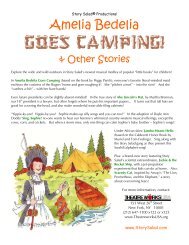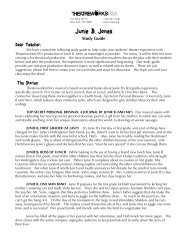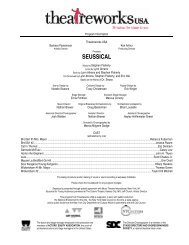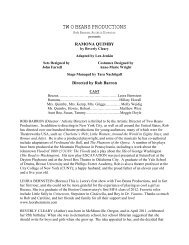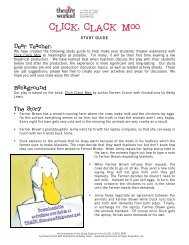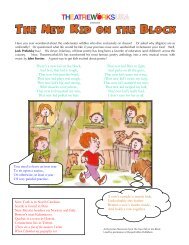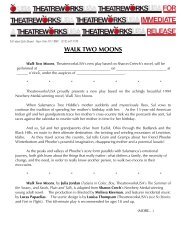Tales of a Fourth Grade Nothing - Theatreworks USA!
Tales of a Fourth Grade Nothing - Theatreworks USA!
Tales of a Fourth Grade Nothing - Theatreworks USA!
You also want an ePaper? Increase the reach of your titles
YUMPU automatically turns print PDFs into web optimized ePapers that Google loves.
4. Review proper theatre etiquette with your class. They may be seeing our show as part<strong>of</strong> a class trip, with many other schools attending. They should carefully follow theirteacher’s or group leader’s directions. During the show, they should be quiet, so thatthey do not disturb other audience members (and the actors!) during the performance.However, actors love cheers and applause, especially at the end <strong>of</strong> the show. This is agreat way to thank actors for all their hard work in performing this show for you!5. Do your students have younger brothers or sisters? Do they always get along? How dothey resolve disputes?6. <strong>Tales</strong> <strong>of</strong> a <strong>Fourth</strong> <strong>Grade</strong> <strong>Nothing</strong> concerns the relationship between a 9-year-old and a3-year-old. In the story, the older brother feels like Fudge gets many more advantages.What are the positive aspects <strong>of</strong> being 3 (having to do fewer chores, for instance)?What are the advantages <strong>of</strong> being 9 (for example, getting to stay up late)? What arethe disadvantages <strong>of</strong> each age? Which age would your students rather be, and why?7. Discuss the concept <strong>of</strong> responsibility. What are your students’ responsibilities in terms<strong>of</strong> schoolwork, family, chores, etc. Do they have more responsibilities now or whenthey were younger? Do they get rewards (for example, an allowance) for actingresponsibly? Should they get these incentives?Post-Performance Discussion1. As soon as possible after the performance, engage your class in discussion about theshow. Who were their favorite characters and why? Which were their favoritemoments in the play? Compare and contrast the book and live performance, as well asother adaptations <strong>of</strong> the story they may have seen. Did the show meet theirexpectations? Why or why not?2. The young adult actors in this production play a wide variety <strong>of</strong> ages… toddlers,elementary school students, parents, bosses and more. What did the actors do withtheir bodies and voices to heighten the illusion that they were younger or older thanthey actually are?3. How did the brothers express their anger and frustration? Compare and contrastFudge’s actions to Peter’s.4. What were some <strong>of</strong> the tricks Peter and his parents played on Fudge to get him tobehave properly? Was this fair to Fudge? Why or why not?5. Peter’s mother apologized for blaming him when Fudge knocked out his front teeth.Have your students ever blamed someone for something they had no control over?How did that make them feel? Did they apologize eventually?6. Fudge drives Peter crazy sometimes, but deep down he really loves his younger brother.How did Peter demonstrate his annoyance with Fudge? How did he show his love forFudge? Is this love/hate relationship realistic? Do your students have similarrelationships with their family members?7. Fudge’s real name is “Farley Drexel Hatcher.” How did he get the nickname Fudge, doyou think? Do your students have nicknames for friends or family? How did they getthese nicknames? Do they like their nicknames? Why or why not?
Activities1. The Most Important Thing That Happened The framing device for this productionis Peter writing an essay about the most important thing that happened to him that year,which leads him to think about everything else that happened to him. Have your studentswrite similar essays. You may also ask them to illustrate them. You can also encourageyour students to keep weekly journals, writing weekly entries about the most importantthing that happened to them within those seven days. To individualize their journals, theycan decorate them with stickers, photographs, drawings, etc.2. Haiku Haiku is a traditional Japanese form <strong>of</strong> poetry. The first line has five syllables,the second line has seven, and the third line has five. These lines do not rhyme. Haveyour students write a haiku about characters and events in <strong>Tales</strong> <strong>of</strong> a <strong>Fourth</strong> <strong>Grade</strong> <strong>Nothing</strong>.Here are a few to get them started:Funny, funny FudgeMom and Dad HatcherDoes not want to eat dinner. Don’t pay Peter attention:“Eat it or wear it!”A fourth grade nothing.3. Judy Blume Stories on Stage! The adaptation <strong>of</strong> <strong>Tales</strong> <strong>of</strong> a <strong>Fourth</strong> <strong>Grade</strong> <strong>Nothing</strong> isvery similar to Judy Blume’s original book, featuring much <strong>of</strong> the same dialogue. Yourstudents cam dramatize chapters from other books to dramatize – they can use Blume’sdialogue, and utilize her descriptions as stage directions. You may also wish to have yourstudents act out the story for their classmates, along with self-devised costumes and props.4. Advertising Peter’s father is an advertising executive… This means that he comes upwith ideas for commercials. Where have your students seen commercials? For example,on television, radio, newspapers, online, billboards, busses, etc. Choose an advertisementand dissect it: who is the ad meant to reach? Does it make your students more excitedabout the product? What makes an ad good or bad? What are the common elements <strong>of</strong> anadvertisement? Have your students design print or radio ads based on their favoriteproducts, or for local establishments and businesses. Maybe they could even create an adfor <strong>Tales</strong> <strong>of</strong> a <strong>Fourth</strong> <strong>Grade</strong> <strong>Nothing</strong>!5. Turtles… And Other Pets In the book and play, Peter takes care <strong>of</strong> his pet turtle,Dribble. Research different kinds <strong>of</strong> turtle breeds and how to take care <strong>of</strong> them. What’sthe best habitat for each kind <strong>of</strong> turtle? How big do they grow? What kind <strong>of</strong> turtle issmall enough for Fudge to swallow? How <strong>of</strong>ten do turtles need food and water? Whatkind <strong>of</strong> food? You may wish to get a turtle (or a hamster, guinea pig, or fish) as aclassroom pet. Have the students take turns caring for the pet.You may also have students research different types <strong>of</strong> pets… Fish, mice, dogs, cats,horses, rabbits, etc. What is required to care for each <strong>of</strong> these pets? How would yourstudents make their pets happy? Which pets are easier to care for? How long do each <strong>of</strong>these types <strong>of</strong> animals live? How are these animals cared for when their owners go out <strong>of</strong>town?6. Transportation <strong>Tales</strong> <strong>of</strong> a <strong>Fourth</strong> <strong>Grade</strong> <strong>Nothing</strong> takes place in New York City, which isso densely populated that most people, including Peter’s family, use alternate forms <strong>of</strong>transportation rather than their own car. What are some other ways <strong>of</strong> getting around acity? What are the advantages and disadvantages <strong>of</strong> each method <strong>of</strong> transportation? (Thistopic is also addressed in a <strong>Fourth</strong> <strong>Grade</strong> <strong>Nothing</strong> chapter not included in the play, “TheyFlying Train Committee.”)7. Teeth-Counting Fudge’s dentist tricks him into opening mouth by saying that he’scounting the boy’s teeth. You can use “teeth-counting” for a number <strong>of</strong> math-relatedexercises. Split the class into groups, and have each member count their own teeth.Each group can add up the total number <strong>of</strong> teeth, and divide that by the number <strong>of</strong>members in the group to discover the average, or “mean” number <strong>of</strong> teeth each grouphas. What is the average/mean number <strong>of</strong> teeth in the entire class? Or in each student’sfamily?
Likewise, each group can list the total number <strong>of</strong> teeth they have in numerical order, lowestto highest. The digit in the middle <strong>of</strong> this group is called the “median.” (This exercisewill work best if each group has an odd number <strong>of</strong> members.)What number occurs the most in each group? This number is called the “mode.”If you wish, you can have students prepare bar graphs and line graphs to graphicallyillustrate the average/mean number <strong>of</strong> teeth in each group.ResourcesWebsites:Judy Blume on the Web (Judy Blume’s website, featuring a biography, bibliography,writing activities, kids’ activities, and more.http://judyblume.com/<strong>Tales</strong> <strong>of</strong> a <strong>Fourth</strong> <strong>Grade</strong> <strong>Nothing</strong> Activities (links to websites featuring moreideas on using <strong>Tales</strong> <strong>of</strong> a <strong>Fourth</strong> <strong>Grade</strong> <strong>Nothing</strong> in the classroom.http://webtech/kennesaw/edu/reading/fourthgradenothing.htmPet Turtle (website covering pet turtle selection and care).http://www.petturtle.com/Advertising Tricks (PBS Kids website featuring activities to help kids betterunderstand advertising concepts and tricks).http://pbskids.org/dontbuyit/advertisingtricks/Other children’s/young adult books by Judy Blume:Picture Books (<strong>Grade</strong>s 1-3)Freckle JuiceThe One in the Middle Is the GreenKangarooThe Pain and the Great One (series)Fudge Books (<strong>Grade</strong>s 2-6)<strong>Tales</strong> <strong>of</strong> a <strong>Fourth</strong> <strong>Grade</strong> <strong>Nothing</strong>Otherwise Known as Sheila the GreatSuperfudgeFudge-a-ManiaDouble FudgeJunior High (<strong>Grade</strong>s 7-9)Are You There God? It’s Me,MargaretBlubberDeenieHere’s to You, Rachel RobinsonIggie’s HouseIt’s Not the End <strong>of</strong> the WorldJust as Long as We’re TogetherThen Again, Maybe I Won’tStarring Sally J. Freedman as HerselfHigh School (<strong>Grade</strong>s 7-12)ForeverLetters to JudyPlaces I Never Meant to Be (editor)Tiger Eyes



